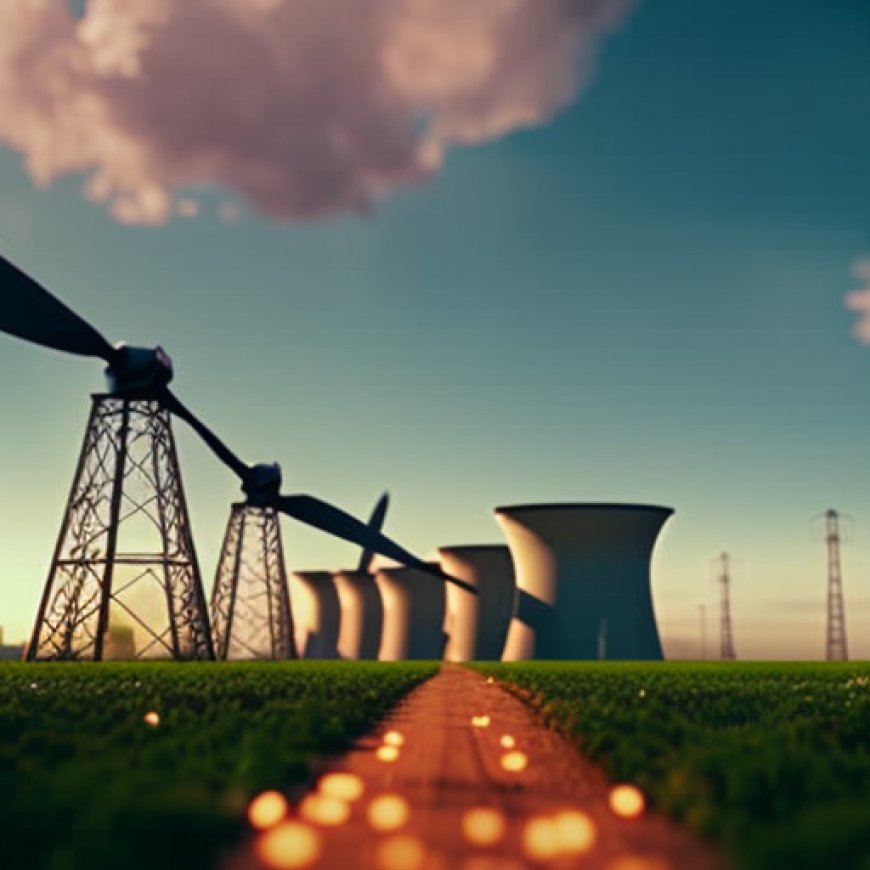The U.S. Clean-Energy Company That Hit the Subsidies Jackpot
The U.S. Clean-Energy Company That Hit the Subsidies Jackpot The Wall Street Journal


First Solar: A Beneficiary of U.S. Green Energy Push
Introduction
Of all the beneficiaries of the U.S.’s green-energy push, few have hit the jackpot like First Solar.
The Arizona-based solar-panel manufacturer expects to receive as much as $710 million this year—nearly 90% of forecast operating profit—from subsidies the U.S. government rolled out a year ago to encourage domestic renewables production. One analyst estimates the incentives could be worth more than $10 billion for the company over the next decade.
Market Dominance and Share Price Surge
First Solar expects to have as much as a 60% share of the U.S. market for large-scale solar installations this year, largely a result of government policies that are pushing clean-energy developers to buy more made-in-America components.
The company’s shares have more than doubled to $208.40 in Friday trade since the beginning of 2022, despite a string of earnings disappointments during that period. Since the passage of the Inflation Reduction Act last August, First Solar has promised so far to plow more than $2.8 billion into new manufacturing and research facilities in the U.S., including a new factory announced on Thursday.
Strategic Approach and Policy Influence
First Solar Chief Executive Mark Widmar credits persistence and smart strategy, saying the company has worked for years to build factories and a supply chain in the U.S. He says the current U.S. energy policy is helpful.
The Biden administration’s signature climate legislation could ultimately provide $1 trillion in support for clean-energy projects, largely through tax credits tied to benchmarks such as the amount of wind power generated or solar panels produced. So far, it has helped spur around $110 billion in announcements for factories and other facilities to make everything from wind turbines to battery components, according to an analysis by The Wall Street Journal.
Most of those projects involve overseas clean-energy giants; many won’t be finished for years. First Solar is one of a handful of big U.S.-based manufacturers with sizable U.S. factories that are already eligible for the incentives.
Competitive Advantage and Lobbying Efforts
Some industry executives attribute the company’s good fortune to luck and sharp elbows as it pushed for policies that would give it an advantage against low-cost competitors from countries such as China, which controls more than 80% of the global supply chain for solar panels.
First Solar also changed business models when needed, says Widmar, who joined the company in 2011 and has steered it through several slumps. The company built factories in cheaper locations such as Malaysia and Vietnam, where it hosted more than 80% of its manufacturing capacity as late as 2018.
At the same time, the company lobbied in the U.S. against cheap Asian imports, pushing to slap duties on solar components made by Chinese companies. Some in the industry say such policies have boosted solar costs in the U.S. and could slow the rollout of renewables.
Future Prospects and Tax Credits
Rules governing the tax credits are still being completed. First Solar says it should be able to qualify for a series of lucrative credits linked to its U.S. panel production. The credits could be worth $11 billion over the next decade, according to a report by Philip Shen, managing partner at boutique investment bank Roth Capital Partners. That is roughly equivalent to the last four years of sales.
First Solar hasn’t received any credits yet, but it is already counting future credits’ value on its books.
A key question is the definition of a U.S.-made solar panel for tax-credit purposes, which could unlock a lucrative incentive meant to spur renewables developers to buy more homemade equipment. Rules favoring First Solar could help boost the company’s sales further, because the company estimates 90% of the pieces that go into its newest panel are already made in America.
Expansion and Investment
First Solar is trying to take advantage of its moment. The company is tapping into buyers’ demand for U.S.-made equipment by amending contracts to stipulate that its panels will be produced domestically, charging a premium for that feature. It is pushing customers hungry for panels to sign multiyear contracts, accumulating an order backlog the company estimates at more than $20 billion.
The company also is investing heavily in research into new solar technologies, and it is building new factories fast. First Solar expects to have more than 20 gigawatts of global manufacturing capacity by the end of 2025, four times what it had at the end of 2018 and one-and-a-half times the amount of large-scale solar the U.S. installed last year. Nearly half of that will be in the U.S.
SDGs, Targets, and Indicators Analysis
1. Which SDGs are addressed or connected to the issues highlighted in the article?
- SDG 7: Affordable and Clean Energy
- SDG 9: Industry, Innovation, and Infrastructure
- SDG 12: Responsible Consumption and Production
- SDG 13: Climate Action
The article discusses the U.S. government’s subsidies for domestic renewables production, the growth of the clean-energy industry, and the impact on solar panel manufacturing. These topics are directly related to SDG 7, which aims to ensure access to affordable, reliable, sustainable, and modern energy for all. The article also mentions the expansion of factories and research facilities, which aligns with SDG 9’s focus on promoting inclusive and sustainable industrialization and fostering innovation. Additionally, the article touches on the commoditized nature of the solar panel industry and the need for responsible consumption and production (SDG 12). Finally, the article highlights the role of clean energy in addressing climate change (SDG 13).
2. What specific targets under those SDGs can be identified based on the article’s content?
- SDG 7.2: Increase substantially the share of renewable energy in the global energy mix.
- SDG 9.2: Promote inclusive and sustainable industrialization and, by 2030, significantly raise industry’s share of employment and gross domestic product.
- SDG 12.2: By 2030, achieve the sustainable management and efficient use of natural resources.
- SDG 13.2: Integrate climate change measures into national policies, strategies, and planning.
Based on the article’s content, the targets mentioned above can be identified. The expansion of the clean-energy industry and the increase in domestic renewables production contribute to achieving SDG 7.2. The growth of factories and research facilities in the U.S. aligns with SDG 9.2. The focus on responsible consumption and production is relevant to SDG 12.2. Finally, the article emphasizes the importance of clean energy in addressing climate change, which relates to SDG 13.2.
3. Are there any indicators mentioned or implied in the article that can be used to measure progress towards the identified targets?
- Percentage of renewable energy in the U.S. energy mix
- Share of employment and gross domestic product contributed by the clean-energy industry
- Efficiency of natural resource use in solar panel manufacturing
- Inclusion of climate change measures in national policies and planning
While the article does not explicitly mention specific indicators, the following indicators can be used to measure progress towards the identified targets. The percentage of renewable energy in the U.S. energy mix can be used to track progress towards SDG 7.2. The share of employment and gross domestic product contributed by the clean-energy industry can measure progress towards SDG 9.2. The efficiency of natural resource use in solar panel manufacturing can be an indicator for SDG 12.2. Finally, the inclusion of climate change measures in national policies and planning can be used to assess progress towards SDG 13.2.
SDGs, Targets, and Indicators Table
| SDGs | Targets | Indicators |
|---|---|---|
| SDG 7: Affordable and Clean Energy | 7.2: Increase substantially the share of renewable energy in the global energy mix. | Percentage of renewable energy in the U.S. energy mix |
| SDG 9: Industry, Innovation, and Infrastructure | 9.2: Promote inclusive and sustainable industrialization and, by 2030, significantly raise industry’s share of employment and gross domestic product. | Share of employment and gross domestic product contributed by the clean-energy industry |
| SDG 12: Responsible Consumption and Production | 12.2: By 2030, achieve the sustainable management and efficient use of natural resources. | Efficiency of natural resource use in solar panel manufacturing |
| SDG 13: Climate Action | 13.2: Integrate climate change measures into national policies, strategies, and planning. | Inclusion of climate change measures in national policies and planning |
Behold! This splendid article springs forth from the wellspring of knowledge, shaped by a wondrous proprietary AI technology that delved into a vast ocean of data, illuminating the path towards the Sustainable Development Goals. Remember that all rights are reserved by SDG Investors LLC, empowering us to champion progress together.
Source: wsj.com

Join us, as fellow seekers of change, on a transformative journey at https://sdgtalks.ai/welcome, where you can become a member and actively contribute to shaping a brighter future.







